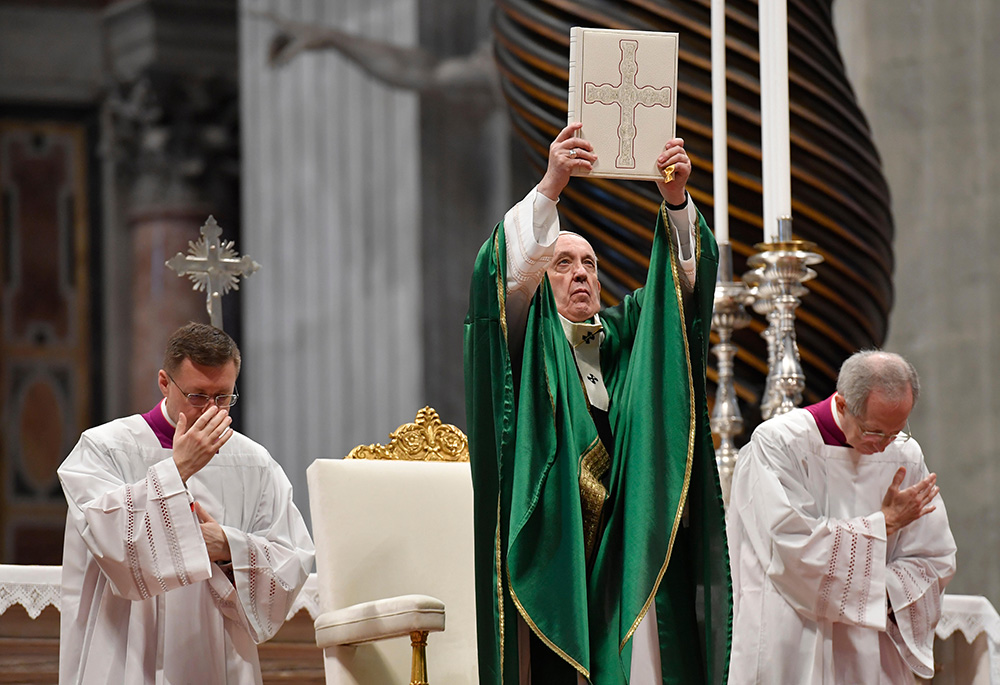
Pope Francis holds up the Lectionary, or book of Mass readings, that was used during the Second Vatican Council. The special lectionary was part of the celebration in St. Peter's Basilica Jan. 26, 2020, the first Sunday of the Word of God, a new annual celebration encouraging Catholics to know and read the Bible, as Vatican II desired. (CNS/Vatican Media)
Editor's note: The following keynote address was delivered at a conference for and with a group of U.S. bishops March 25-26 in Chicago. "Pope Francis, Vatican II, and the Way Forward" was co-organized by Loyola University Chicago's Hank Center for the Catholic Intellectual Heritage, Boston College's Boisi Center for Religion and American Public Life, and Fordham University's Center on Religion and Culture. Also helping with the organization was NCR political columnist Michael Sean Winters.
The first thing to acknowledge when we talk about the Second Vatican Council today is the gap between the horizon of expectations raised by the council and the situation of the Catholic Church today, especially in this country. Vatican II called Catholics to unity: unity in the one human family, with non-Christians and non-believers, with Christians of other traditions, and with fellow Catholics.
But in these last few years we have seen that the fundamental call of Vatican II to unity through reconciliation has often turned into a source of bitter division and contention, at times dangerously flirting with schism. This is paradoxical because reconciliation is maybe even more original as an intent of Vatican II than the call to church reform.
We have seen all this with shocking clarity during the pontificate of Francis. This is more than a chronological overlap. There is a parallel between the rejection of Vatican II and the relationship between the church in the United States and Pope Francis. The opposition to Pope Francis is rooted in the opposition to Vatican II — a theological crisis that did not begin with this pontificate.
This is a problem that is not just theological, but also ecclesial, that is, it has profound consequences for the ways in which all Catholics experience their life of faith in the church. Therefore, it is a problem that needs to be addressed. Also, because it would be naive to think that it's a problem created by Francis and that it will disappear with the next pontificate. Hence, this is the attempt at an analysis of the problem and to offer some possible solutions.
Phases in reception of Vatican II
Despite some limitations in the wording in the final documents about the need of the church to reckon with the past, Vatican II took history seriously. We should do the same thing for the history of the post-Vatican II period, that is, try to identify different historical phases in order to comprehend the origins of a crisis in the reception of Vatican II.
One way to look at the issue of the reception of Vatican II is that the reception of a council like Vatican II takes a long time, at least a century to be fully implemented. This is true if one looks, for example, at the history of the reception of the Council of Trent. The greatest historian of the council of Trent, German Fr. Hubert Jedin remarked, in the very first lines of his multi-volume History of the Council of Trent, that the first century after the end of the council was shaped by the clash of historical and theological narratives on the council between the Venetian Servite Brother Paolo Sarpi and the Roman Jesuit Francesco Sforza Pallavicino. Only three centuries later, in the middle of the 20th century, it had become possible to write an account of that theological and ecclesial turning point that Trent was — something more than a battle between "accusation and defense."
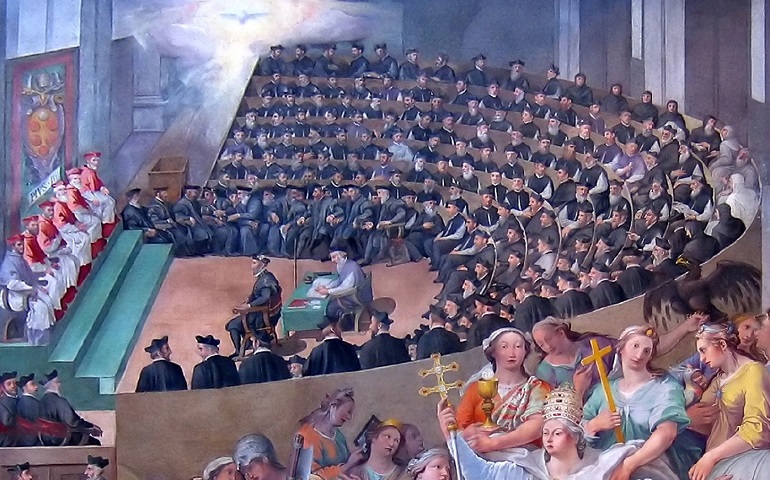
"Council of Trent," a 1588 painting by Pasquale Cati in the Basilica of Santa Maria in Trastevere in Rome (Wikimedia Commons/Anthony Majanlahti)
At the same time, choosing a mechanistic periodization — that is, expecting that the full reception of Vatican II will necessarily happen in the next 50 years or 200 years — is risky because it ignores the fact that in church history there have been failed councils: councils that did not accomplish their stated goals (the Council of Ferrara-Florence of 1438-1445, a council of "union" with the Eastern Orthodox Churches), or that fundamentally missed what was going on (the Fifth Lateran Council, 1512-1517, concluded immediately before the beginning of the Reformation), or that were overwhelmed by external factors and whose trajectory became substantially different from what the council had in mind (the Council of Moscow for the Russian Orthodox Church, 1917-1918).
Now, Vatican II is not a failed council. There is — despite the well-known differences and tensions — a fundamental consensus between papal magisterium, the sensus fidelium in the people of God, and the theological tradition on the fact that the teachings of Vatican II represent a development, a growth in our understanding of God's Revelation. If anything, the "signs of our times" represent evidence of the necessity of the reorientation of the Catholic Church at Vatican II.
But we must acknowledge that we live in a time of interruption in the reception of Vatican II in the U.S. — and this crisis has been there for quite some time. We need to understand the present state of the reception of Vatican II, especially in the U.S., in order not to be trapped into narratives that posit a direction toward a pre-determined end.
In the literature on Vatican II, there are different periodizations of the post-conciliar period. Few of them try to deal with the fact that Vatican II was a council for the global church, received by the global church in a timeline that may vary dramatically from country to country and continent to continent. Periodizations of the post-Vatican II years still tend to cling to perspectives tied to national or (at best) continental histories. We still do not have a global history of the post-Vatican II Catholic Church, and even less an accepted narrative of the global post-Vatican II period — something that is more possible for the reception and application periods of previous councils, given that their impact can be measured on a Catholic Church that was predominantly European and Mediterranean (at least in its idealized models).
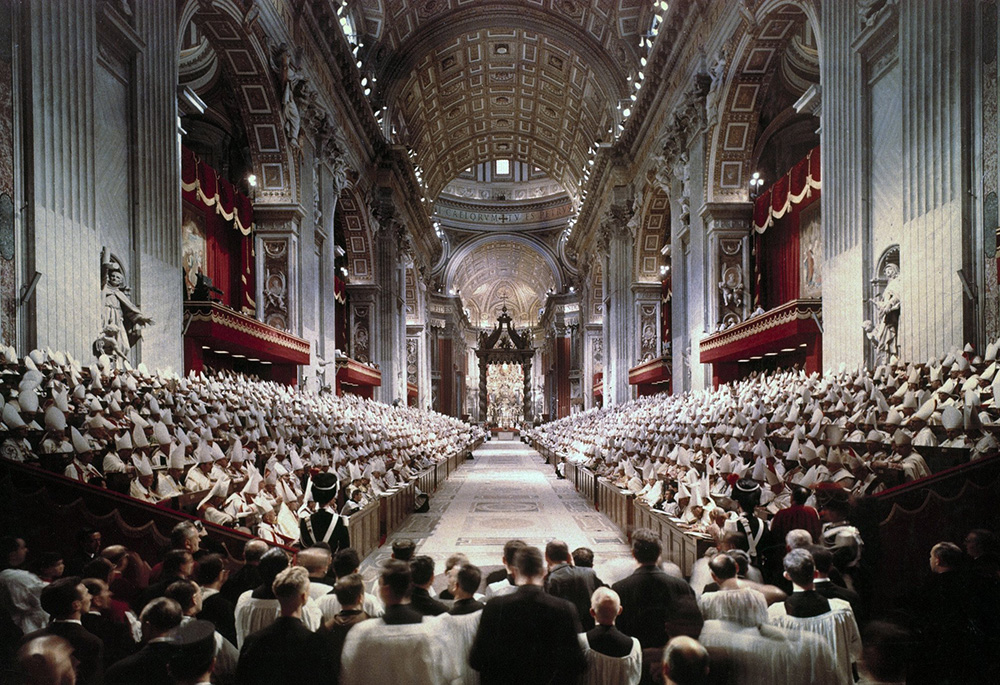
The opening session of the Second Vatican Council in St. Peter's Basilica at the Vatican Oct. 11, 1962. In the Dogmatic Constitution on the Church (Lumen Gentium), the council described the family as the "domestic church." (CNS/Catholic Press Photo/Giancarlo Giuliani)
But for our intent here it suffices to divide the first three decades in three periods. The first is the age of Vatican II acknowledged, received or rejected — the 15 years between 1965 and the end of the 1970s: the time of the implementation of the liturgical reform, of the translations and dissemination of the final texts of the council, of the great commentaries written mostly by those men who helped draft the final texts of the council. The rejection of Vatican II was limited to small fringes of extremists — fringes both in the church and society — that articulate their opposition on the basis of nostalgia for pre-secularization Christendom and allegations of violation by Vatican II of the continuity of tradition. It was not yet based on sociopolitical arguments, that is, the alleged evidence of the failure of Vatican II to reframe the relations between the church and the world.
A second period is the one of Vatican II remembered, reconsidered and expanded — the 1980s. It is the time of Pope John Paul II's effort to stabilize the reception of Vatican II by keeping "letter and spirit" together (the extraordinary synod of 1985) and to "institutionalize" Vatican II (the Code of Canon Law of 1983, the 1992 catechism project launched after the 1985 synod). At the same time John Paul II pushed the teaching of the church beyond the boundaries of the letter of Vatican II, especially on ecumenism and interreligious dialogue (with Judaism and Islam in particular).
The third period is the one of Vatican II historicized and lamented — the 1990s and the early 2000s: the period of the effort to write the master narrative on the history of Vatican II while at the same attempting to narrow down the import of the openings of the council by the institutional church in a rebuke to the appeals to the "spirit." But there was still among Catholics of the two aisles a fidelity (although sometimes nominalistic) to the letter of Vatican II and to the legitimacy of the conciliar tradition that extends to and includes Vatican II.
It is in this third period, 30 years from the celebration of the council, that the crisis of the reception of Vatican II in the U.S. begins, and this activates the diversion of large pockets of U.S. Catholicism from an ecclesial reception of Vatican II.
On the one side, there is the beginning, in academic theology, of symptoms of detachment from the institutional church but also from a connection with the lived experience of the people of God, in ways that are more drastic than anywhere else in global Catholicism. It is the rise of a post-ecclesial horizon also thanks to a false polarity between institution and society as argued by Italian philosopher Roberto Esposito. It was not just a healthy relativization of the institutional church in favor of the transcendent. It was also the failure to recognize that also the institutional element in Catholicism allows different kinds of theological-spiritual cultures and different subjects to build the catholicity of the church.
But we must acknowledge that we live in a time of interruption in the reception of Vatican II in the U.S. — and this crisis has been there for quite some time.
On the other side, there is the neoconservative ideologization of Catholicism, which still showed in the 1990s a certain amount of respect (at least nominally) for Vatican II. It's the long wave and the American Catholic version of the "comeback of God" in politics which Gilles Kepel wrote about three decades ago. But in the U.S. there is also the dangerous turn on its head of a clerical culture of identification of Catholicity with one particular model of papal leadership. On the conservative and traditionalist side of the spectrum, in the early 2000s the papacy is still providing important legitimacy to Vatican II.
But Pope Benedict XVI's interpretation of Vatican II was different from John Paul II's. From Benedict's famous — and often misquoted — speech to the Roman Curia of Dec. 22, 2005 onwards, the polarity of "continuity and reform versus discontinuity and rupture" became something like a mantra. The argument of "continuity with the tradition of the council," presented at the beginning as an argument against the Lefebvrite thesis of Vatican II as a "rupture" with the Catholic tradition, soon turned against any idea of "reform" — which was in fact an integral part of that pivotal December 2005 speech by Benedict XVI.
This protection given by the papacy to the legitimacy of Vatican II, lasts only until the end of Benedict's pontificate and dangerously made it easier to trade one kind of ecclesial source of identity for another in favor of a new papalism. This happens at the expense of a healthy sense of the Catholic tradition — which was ironic or tragic for a theologian, like Joseph Ratzinger, who was among the main authors and interpreters of key documents of the council such as Lumen Gentium and Dei Verbum.
One of the effects of the identification in the U.S. between Benedict XVI's pontificate and Catholic resistance to theological progressivism was the creation of the premises for the transition from Vatican II conservatism to a neo-traditionalist rejection of Vatican II among the Catholic intellectual and clerical elites in the U.S. It was a key turn: a rejection not anymore just of the vague appeals to the "spirit," but also a rejection of the letter, of the documents of Vatican II and their theology. The explosive effects of this expansion of the anti-conciliar Catholic front became clear beginning in March 2013.
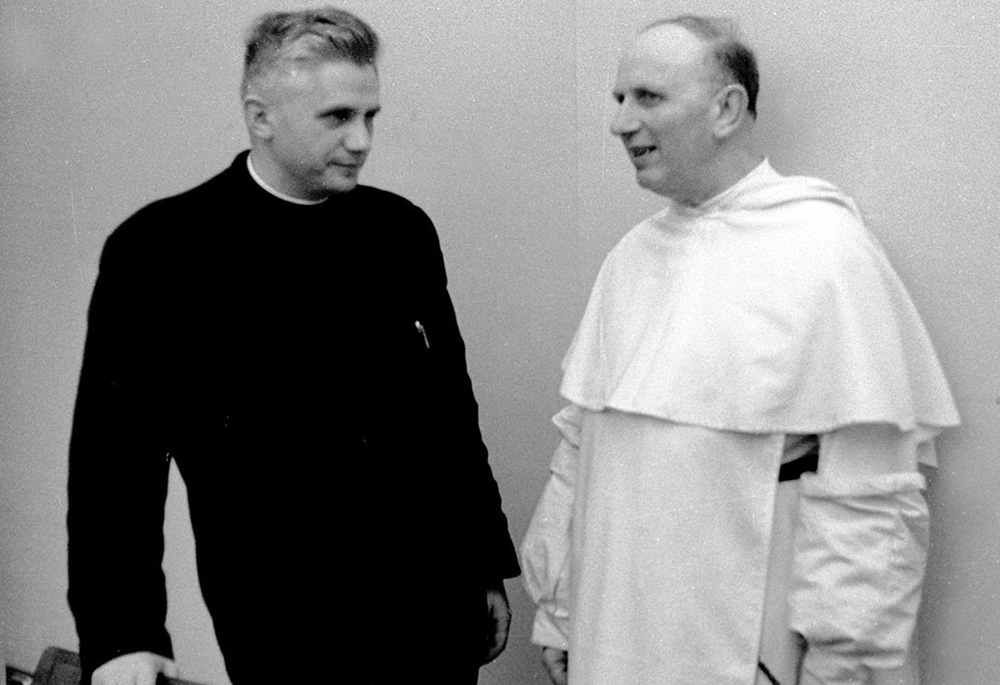
Fr. Joseph Ratzinger is seen with French Dominican Fr. Yves Congar during the Second Vatican Council in 1962. Ratzinger, who became Pope Benedict XVI, gained a reputation as a progressive theologian during Vatican II. (CNS/KNA)
A new phase with Francis
The interruption in the reception of Vatican II has become a crisis of ecclesial communion during the pontificate of Francis. But this started even before the beginning of his pontificate: the neoconservative and neo-traditionalist voices within the U.S. episcopate felt orphaned suddenly on Feb. 11, 2013, when Benedict XVI announced his resignation. There were orphans of Benedict's pontificate in the Roman Curia, among bishops, theologians and politicians. But this sense of loss was particularly acute in the U.S. because of the (largely mistaken) feeling that Joseph Ratzinger — Benedict XVI — had turned the table on Vatican II: the expectation that he had settled forever the disputation on the interpretation of the council — as prefect of the Congregation for the Doctrine, or CDF, of the faith first and then as pope.
But the globalization and de-occidentalization of Catholicism — one of the strongest intuitions of Vatican II — had an effect on the conclave of 2013. Not just a pope "almost from the end of the world," as Francis said in his first address to the people gathered in St. Peter that night of March 2013. Francis's pontificate has coincided with, and in part contributed to, the transformation of the transatlantic ecclesial bond between the papacy and American Catholicism.
This is based on the fact that the election of Pope Francis on March 13, 2013, has indubitably changed the landscape of the church and especially of the debate on Vatican II. From the very first weeks and months of his pontificate, Pope Francis showed a full and unequivocal reception of Vatican II, also thanks to the theological and ecclesial debate on Vatican II, which in these last 50 years never ceased to be part of the real life of the universal church.
Pope Francis inaugurated a new phase in the reception of Vatican II, and not only for the disappearance of the defense of traditionalist, anti-Vatican II issues from the agenda of Pope Francis and his Roman Curia (in the CDF especially). The pontificates of the last century have all been defined (in different measures) by the historical-theological debate in relation to the council: Pius XII, the pope most cited in the documents of Vatican II, and his failure to reconvene Vatican I; John XXIII, convener of the council; Paul VI, who was explicitly elected to continue the council, and that led him to its conclusion at the cost of significant compromises with some of the dreams of reform that emerged from the council; John Paul I, "second row" council father; John Paul II, the last pope who was a member of Vatican II, a key-figure of Vatican II and at the same time "stabilizer" of the council; Benedict XVI, one of the most important periti of Vatican II and as pope and cardinal the most important theological "enforcer" of the council and its interpretations.
Pope Francis stopped this line of popes biographically involved in Vatican II for biographical reasons (he was ordained a priest in 1969), but also for the specific heritage of the church in Latin America. The Argentine Jesuit Bergoglio perceives Vatican II as a matter that should not be reinterpreted or restricted, but implemented and expanded (on some issues more than others). His reluctance to theorize on different kinds of hermeneutics of Vatican II should not be seen as indifference or ignorance of the centrality of the hermeneutical question.
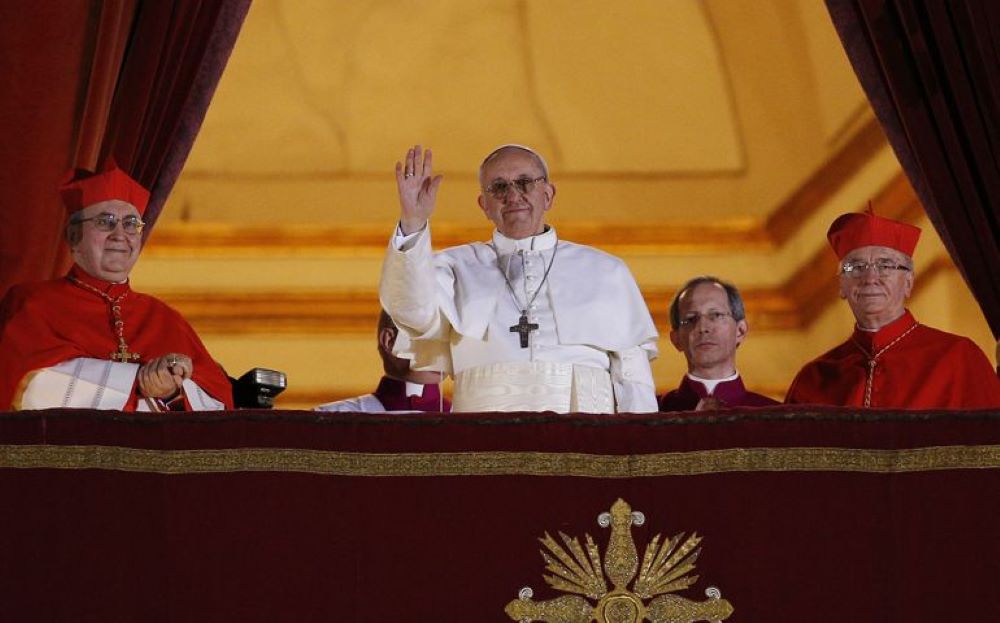
Pope Francis appears for the first time March 13, 2013, on the central balcony of St. Peter's Basilica at the Vatican. (CNS/Paul Haring)
Faithful to the intuitions of Vatican II (which are expressed in only a partial manner in the final documents of the council), Francis speaks of the theological value of spiritual poverty as a condition of accepting the Gospel of Jesus Christ, and proposes a radical and continuous need for the church and Christians to be next to the poor, in the sense of existential and economic poverty. This emphasis on social justice is part of Francis' ecclesiology, an "ecclesiology of the people of God" that has clear implications also on the level of a more conciliar style and structure of church government. Francis talks about a greater collegiality with the bishops and synodality at various levels in the church. Francis' documents and gestures of dialogue with Islam parallel only with John Paul II's documents and gestures of dialogue with the Jews.
But the problem of the authority of Vatican II as part of the tradition has not been solved and it has become more serious in the situation pope Francis inherited. Especially around Traditionis Custodes and the liturgical issue in light of the ecclesiology of the liturgical reform, there have been some mixed and confusing signals from the Holy See in recent months.
However, it is still true that in Francis there is a particular way of talking about Vatican II without explicitly mentioning it or quoting its documents. This is also an expression of the refusal to identify Vatican II with the letter of its documents in a legalistic way. Francis talks about Vatican II without falling into veterans' sentimentality. He does this through the Catholic tradition of which Vatican II has become part: through quotations of St. Paul VI, by letting documents of bishops' conferences speak in his encyclicals and exhortations, and by recovering the fundamental intuitions of Vatican II as an integral part of the mission of the church.
Francis' philosophy of the polarity in tension is still trying to solve the polarization between opposite extremisms on Vatican II: between those who see Vatican II as too modern to be Catholic and those who see it as too Catholic to be modern; between the status quo narrative and a post-ecclesial narrative; between the spirit and the letter; between ressourcement and aggiornamento; between defense of a Tridentine institutional system and naive dreams of a tabula rasa.
One of most important contributions of Francis to the reception of Vatican II has probably been in terms of "exorcizing" the opposition — in the sense of revealing the non-ecclesial or anti-ecclesial spirits that drive the rejection of Vatican II. We have seen this lately on the issue of the liturgical reform, which is historically the way in which the opposition to the teachings of Vatican II tried to find an impossible legitimacy with an argument from tradition which is actually a rejection of the way in which Catholic tradition works.
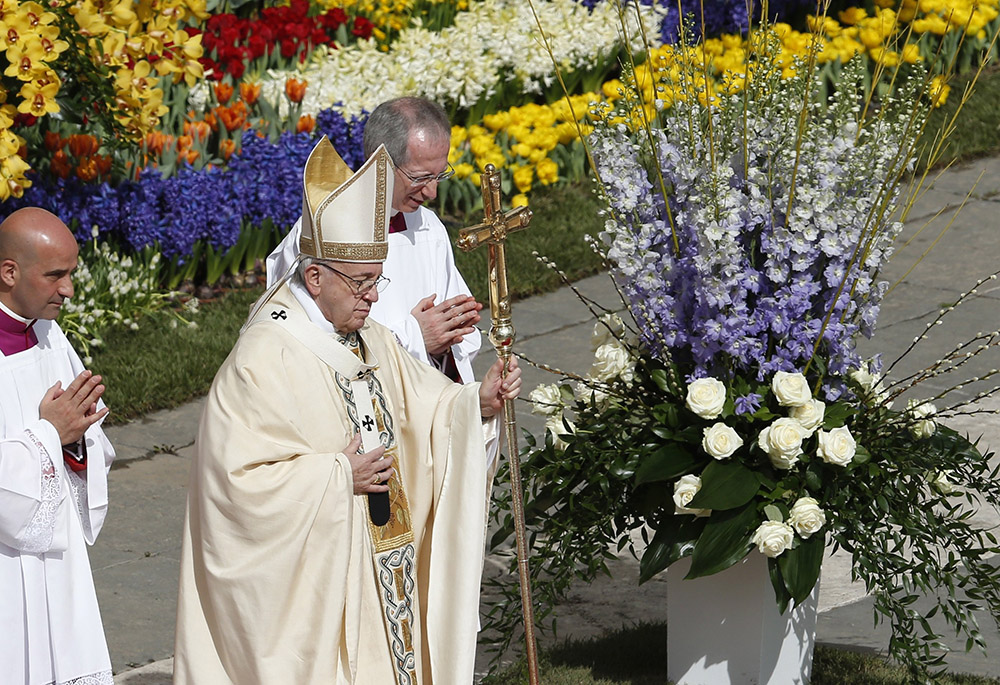
Pope Francis walks past flowers as he celebrates Easter Mass in St. Peter's Square at the Vatican in this April 1, 2018, file photo. Although Western and Eastern Christians celebrate Easter on different dates most years, since the Second Vatican Council, the Vatican has been open to a common date for Easter. (CNS/Paul Haring)
Current ecclesial disruption and Vatican II
What we have seen during the last nine years in the Church in the U.S., in terms of opposition to Pope Francis, defies imagination and has also distorted our expectations about the church in dangerous ways. We have witnessed unprecedented, rebellious challenges — sometimes coming from members of the clergy — to the legitimacy of the bishop of Rome that are clearly incompatible with the sensus ecclesiae. It's a phenomenon not limited to social media. It's something fundamentally different from the "dissent" against some aspects of papal teaching that we have seen under Paul VI, John Paul II and Benedict XVI. And it's something that must be denounced for what it really is, without tactical silences and without complacency.
This does not mean that we can ignore the context in which this ecclesial disruption occurs. First, there has been a change in the perception of Vatican II compared to the early post-conciliar period. It used to count as among the most important in church history. Some saw it as a deliverance, others as a catastrophe, but they agreed that it had changed the church. For over 50 years, this verdict stood more or less unchallenged. No longer. Postmodern critics deconstructed the grand historical 'metanarratives' in which the revolutions could have a central place. The rise of a global, post-colonial or de-colonial sensibility has called into question Vatican II's seemingly most significant achievements.
Christianity and the Catholic Church in this country is an integral part — and on both sides of the aisle — of what has been called by Indian essayist Pankaj Mishra "the age of anger" — a world in which those who were unable to enjoy its promises of freedom, stability and prosperity were increasingly susceptible to demagogues. Mishra (in general, not a big fan of Catholicism) called Pope Francis "the most convincing and influential public intellectual today. … In a piquant irony, he is the moral voice of the Church that was the main adversary of Enlightenment intellectuals as they built the philosophical scaffolding of a universal commercial society."
The context for the ecclesial disruption has been different in different areas, but in the U.S. the situation is very particular: While the Catholic left's narrative about Vatican II is not clear, on the right side of the spectrum the view of Vatican II as a catastrophe has resisted the post-modernist deconstruction, for different reasons. In just 20 years, this is a church whose members have seen the pendulum swing from the Great Jubilee of 2000 to the revelation of sexual abuse involving some of the most powerful members of the hierarchy — U.S. Catholicism being the ground zero for the global abuse crisis in the church. Theological and political polarization have fueled one another — a theologization of political identities and a politicization of the ecclesial discourse.
Another key factor is the shift in perceptions of ecumenism and interreligious dialogue between the time of the council and now, in this post-9/11, new Cold War, 21st-century world. We have moved from a narrative of encounter to a narrative of clash and conflict. Compared to the 1960s and '70s, Catholicism has to engage with more assertive (both religiously and politically) faiths around the world, as well as with a more assertive secularism. This has coincided with a rise of converts who bring a different set of expectations to their understanding of church tradition, which gives greater emphasis to the fathers of the church, the catechism and papal teaching than to the conciliar tradition, including Vatican II. And this in turn introduces new interpretations of historical periods.
What we have seen during the last nine years in the Church in the U.S., in terms of opposition to Pope Francis, defies imagination and has also distorted our expectations about the church in dangerous ways.
Overall, it is undeniable the enormous gap in terms of expectations between the generation of Catholics that grew up with Vatican II and the young generations in our parishes, classrooms and workplace. The situation of the church and the world of today echo less the "joys and hopes" and more luctus et angor, "the griefs and the anxieties" (the words immediately following the incipit of Gaudium et Spes).
But there are also systematic-theological weaknesses in the reception and transmission of the conciliar teaching that have made Catholicism subject to infiltration or even an engine of anger and disenchantment:
- The liturgical debate as part of post-modern identity politics and of the "culture wars";
- Ecclesiology reduced to mimic social imagination (from Bellarmine's societas perfecta to secular models of "perfect society"), and an ecclesial imagination largely surprised if not puzzled by Francis' call to synodality — the synodal "walking together" having to fight against a "walking out" mentality according to the new "extra Ecclesiam, sola salus" (the only salvation is in leaving the church);
- A loss of the theology of Dei Verbum on the approach to God's revelation as sacramental, open to growth in understanding, fundamentally different from both intellectualism and doctrinalism;
- The reduction of religion to notions and to ethics, in an environment dominated by the sometimes utopian nature of prophetic indictment for the voice of religion in our public discourse;
- The embrace of economic and social libertarianism (as we have seen during the COVID-19 pandemic in these last two years) contributing to the crisis of our democracy – a result of the damnatio memoriae of Gaudium et Spes (which is one of, if not the most important documents of Vatican II for Pope Francis);
- A reduction of the conciliar doctrine of religious liberty to a libertas Ecclesiae echoing medieval Christendom;
- A politically partisan kind of ecumenism that has made urgent the need for intra-Catholic ecumenism;
- The globalization of the American "culture wars" that has given us the grim dividend of a visible lack of unity on critical domestic (the Jan. 6, 2021, assault on Capitol Hill) and international emergencies (the war in Ukraine): a lack of unity not just on policies, but on the very moral and spiritual nature of the clash between democracy and authoritarianism.
The list of forgotten conciliar teachings could go on. But the most disturbing phenomenon is the transition from a crisis of ecclesial authority to a crisis of the authority of Vatican II and therefore a collapse of a healthy sense of the tradition: a dynamic and organic idea of the tradition; the letter of the tradition not as a paradigm of understanding, but as an expression of the act of understanding; a shift from cognitive and propositional to a personalist and dialogical understanding of revelation.
The public debate in the church among theologians and bishops seemed to have been replaced by a creeping schism created by the ones who see in the interpretation of Vatican II a point of rupture now more symbolic than textual: From this point of view, we were now well beyond the dialectic "letter vs. spirit" or "event vs. documents." No longer just the spirit or the event, but also the same letter and the documents of Vatican II are now under the influence of revisionism and revanchism — which has nothing to do with the idea that the texts of Vatican II are not the final word: They too are subject to growth in understanding.
The most typical and tragic aspect of the crisis of reception of Vatican II — for a country rich in resources like the U.S. — is an "interruption" in the scholarly tradition of studying the council. Studying the council requires fluency in Latin and other languages, and an intellectual ecosystem in which theology is grounded in conversation with church history and the history of theology, not just social sciences. For example, there is still no consensus on the English translation, the last one of which is now more than 25 years old. (This is far from a purely theoretical problem: in a recent article, Australian Jesuit Gerald O'Collins pointed out the fact that the English translations of the documents of Vatican II basically canceled the explicit references to lectio divina, mistranslated with "spiritual reading" which does not involve meditation and is engaged with non-scriptural texts). There are important studies on the U.S. and Vatican II, but the last American history of Vatican II is John O'Malley's What Happened at Vatican II, published in 2008 during the pontificate of Benedict XVI.
A related factor is a breakdown of the coexistence and collaboration that used to characterize the "working relationship" between professional theologians, Catholic laity, and the institutional and hierarchical church. For the church in Latin America and in Europe, for example, one can clearly see that in the post-Vatican II period there have been three distinct phases:
- The honeymoon between bishops and theologians at Vatican II;
- A time of divorce or separation beginning in the late 1970s and 1980s until the early 2000s;
- In the last decade, glimpses of reconciliation also thanks to the pontificate of Francis.
This reconciliation is not happening in the U.S. This a result of the dangerous intra-Catholic tensions — ecclesial and political — that have developed in this country over the years since the publication of multivolume commentaries on the documents of Vatican II. Other countries have not experienced this to the same degree; in the past two decades, large networks of theologians in Italy, Germany, Spain and Latin America have produced (or at least translated in their languages) important series of Vatican II commentary. The lack of historical-theological work on Vatican II in the United States has consequences for Americans who wish to study the council but also for all U.S. Catholics. There seems to be more space now in the Catholic theological academy for pre–Vatican II and anti–Vatican II theology on one side, and a post–Vatican II theology with fewer discernible ecclesial commitments on the other side. Vatican II itself is caught in something of an intellectual and ecclesial no man's land.
Advertisement
Vatican II and synodality: walking together versus walking out
This is a moment of ecclesial crisis in the context of a larger cultural, political and social crisis. But in these last 60 years, the Catholic Church in the U.S. has been and is an important part of the process of reception of Vatican II just like and, in some cases, more than other churches around the world. Our church in this country has at its disposal vast resources and a vitality that is not easy to find in other churches.
For a recovery of Vatican II and of Pope Francis' pontificate and, in the long run, of a healthy sense of the church, there are two possible ways to tackle the sorry state of reception of the council in our church – and this is a route that requires the leadership of the bishops to be followed by the clergy, theologians, lay leaders in this vast world that is American Catholicism.
The first way is theological:
- It is necessary to recover Vatican II integrally, not just the four constitutions, but all the documents, as some of them are usually and unjustifiably ranked inferior (especially Nostra Aetate on non-Christian religions and Dignitatis Humanae on religious liberty).
- All final documents of Vatican II are indispensable to let the entirety of Vatican II speak in an intertextual way and dialogical with papal teaching.
- We must take seriously the historicity of the council, not just the letter of the documents, but also the spirit of the council, without ever separating or opposing the two, as the extraordinary Synod of Bishops of 1985 said.
- We should acknowledge the issues on which Vatican II was silent or came too early and acknowledge that some aspects of conciliar theology are in need of completion in a way compatible with the modus procedendi of the tradition — something that has happened already also thanks to papal teaching: on women, on racism, on colonialism. This can be done without accusing Vatican II of being cheap and recognizing the debt that we owe to the council fathers, the periti, and all those who contributed to what we call "Vatican II."
- All this does not and need not happen in events remembering Vatican II, fueling veterans' sentimentality on the one side and putting off the younger generations on the other side. Our theological language needs to be unapologetically conciliar, even and especially without the label "Vatican II."
Second, at the level of ecclesial life:
- It is urgent to detach Vatican II from partisan narratives — ecclesially partisan and politically partisan. Just like other groups in American Christianity, "Vatican II Catholics" must stop consulting themselves for guidance.
- There is no future for Vatican II and Catholicism in general without the inclusion of Latino and Black and Asian American Catholics. Vatican II is still perceived in the U.S. (also in academia) as "the last big thing" (not the next) for white-European Catholicism.
- It is urgent to bridge the gap between bishops and theology. This is not just hurting the bishops and theology, but the entire church.
- Synodality is the great opportunity to revive an inclusive, healthy sense of the church As John O'Malley wrote recently in America magazine: "although Pope Francis' call is altogether traditional, it is radically new in the breadth it envisages. This should not scandalize us but energize us. We are entering upon a great project, and our responsibility for its success is as great as the project itself."
In conclusion, as Pope Francis wrote in the preface of a recent book co-authored by Cardinal Michael Czerny and Christian Barone, "it is necessary to make more explicit the key concepts of Vatican Council II, the foundations of its arguments, its theological and pastoral horizon, the arguments and the method it used."
Francis' pontificate is embattled, at the theological level, largely and mostly because of his recovery of the council. But this battle for the meaning of Vatican II will be with us for a long time. At stake is not just the communion with the bishop of Rome, but also the viability of the Catholic magisterial and intellectual tradition.




